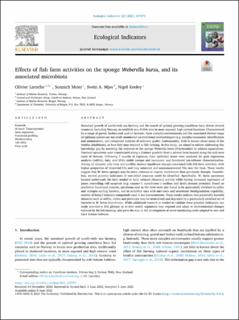Effects of fish farm activities on the sponge Weberella bursa, and its associated microbiota
Journal article, Peer reviewed
Published version

Åpne
Permanent lenke
https://hdl.handle.net/11250/2768691Utgivelsesdato
2021Metadata
Vis full innførselSamlinger
- Department of Chemistry [432]
- Registrations from Cristin [9489]
Sammendrag
Sustained growth of world-wide sea farming and the search of optimal growing conditions have driven several countries, including Norway, to establish new finfish sites in more exposed, high current locations. Characterized by a range of gravel, broken rock and/or bedrock, these complex environments and the associated diverse range of epifauna species are not easily monitored via traditional methodologies (e.g. morpho-taxonomic identification and enumeration, and compound analyses of sediment grabs). Consequently, little is known about many of the benthic inhabitants, or how they may respond to fish farming. In this study, we aimed to initiate addressing this knowledge gap by assessing the response of the sponge Weberella bursa (Polymastidea) to salmon aquaculture. Fourteen specimens were translocated along a distance gradient from a salmon farm located along the mid-west coast of Norway. Following 7 months of exposure, their epithelial tissue were analysed for gene expression analysis (mRNA), fatty acid (FA), stable isotope and taxonomic and functional microbiome characterization. Among all datasets, only fatty acid profiles showed significant changes associated with fish farm activities, with higher proportion of terrestrial FAs and long saturated and monounsaturated FAs near the farm. These results suggest that W. bursa sponges may be more resistant to organic enrichment than previously thought. Nonetheless, several putative indicators of non-lethal response could be identified. Specifically, W. bursa specimens located underneath the farm tended to have reduced ribosomal activity while having increased expression of genes controlling cell apoptosis (e.g. caspase-3, cytochrome c oxidase and death domain proteins). Based on predictive functional analysis, specimens near to the farm were also found to be particularly enriched in sulfur and nitrogen cycling bacteria, and in microbial taxa with anti-toxin and xenobiotic biodegradation capability, notably of benzyl benzoate compounds used in sea lice treatments. These results indicate that potentially harmful elements such as sulfite, nitrite and pesticides may be neutralized and degraded by a particularly enriched set of bacteria in W. bursa microbiome. While additional research is needed to validate these putative indicators, our study provides a first glimpse as to how sessile organisms may respond and adapt to environmental changes induced by fin fish farming, and pave the way to the development of novel monitoring tools adapted to mix and hard bottom habitats.
